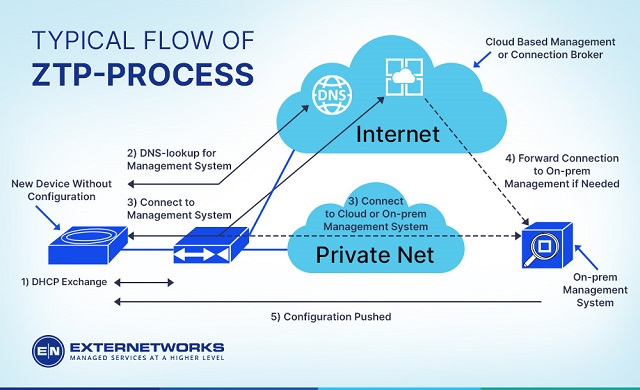What is Zero-Touch Provisioning?
Adding new devices to a network requires a lot of manual labor. Zero-Touch Provisioning, also known as ZTP, is a method of automatically configuring new devices in an automated way. ZTP can help Information Technology (IT) teams quickly deploy network devices in a big environment and eliminates the requirement for most of the manual labor that is normally necessary.
ZTP is found on tools and devices such as routers, network switches, firewalls, and wireless access points. The main goal of ZTP is to reduce human intervention as much as possible. This is not only because manual configuration takes time, but also because it is prone to errors as well—especially when many devices are involved. To set up devices faster in a way that protects the company from errors, ZTP is used.
Features of Zero Touch Provisioning
There are many features of Zero Touch Provisioning that make it an important tool for businesses:
- ZTP reduces human error
- ZTP decreases human intervention
- ZTP can be used on various devices, such as firewalls, network switches, etc.
Some additional advantages include the following:
1. Automated network device set-up
With the help of ZTP, one can streamline the process of adding devices to a network, thus reducing the number of resources required to manage the network.
2. An efficient tool for IT personnel
IT professionals no longer have to worry about the extra workload associated with the addition of new devices to a network. With ZTP, many repetitive tasks can be reduced that otherwise would have to be performed by IT personnel. This way, the team can work on other, more important tasks.
3. Saves cost
The time saved by using ZTP directly helps companies save tons of money. In addition, ZTP also helps you cut down the cost of bringing in an expert from outside. Thus, more savings.
4. Reduces Human Error
ZTP reduces human involvement as much as possible. This helps eliminate human error.
Read also: Cara Menggunakan Vivo Sebagai Remote Control (TV, AC, DVD, Proyektor)
Cons of ZTP
Zero-Touch is a solution for handling various tasks and issues that occur in a business. Despite the numerous advantages, there are also a few cons to this process.
Device Support
By its very nature, ZTP is a one-size-fits-all kind of automated solution. While this may fit the vast majority of devices, there may specific devices that are poorly supported and require manual intervention. This can lead to user frustration and complaints.
Misconfiguration
Configuration problems occur when the configuration files are not properly debugged before being used. When ZTP is used to configure a large number of devices at the same time, misconfigurations may occur in large numbers. While ZTP also makes it far easier to fix any problems across hundreds of devices, it is also imperative for all scripts and settings to be properly checked prior to implementing a ZTP policy.
Read also: 108+ Kata Kata Promosi Jualan Baju Online Shop Yang Menarik
Conclusion:
The number of edge devices—i.e. devices that control data flow at the boundary between two networks—is increasing daily. The requirements for internet and cloud applications in enterprises have also increased.
IT enterprises can now configure new virtual functions with Zero-Touch Provisioning, as it allows IT sectors to update their software automatically. It also offers pre-configured initial configuration and update scripts. Moreover, it caters to and resolves challenges that emerge due to the high usage of network function virtualization in modern companies.
